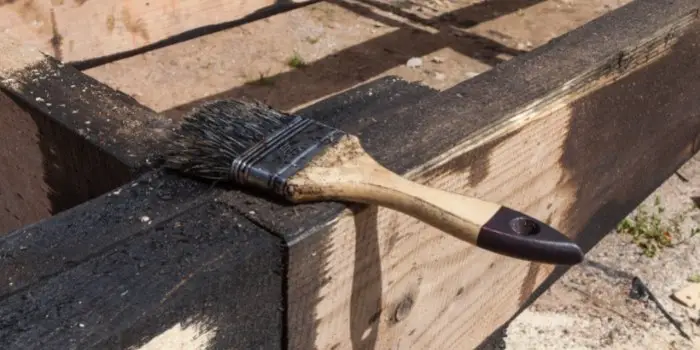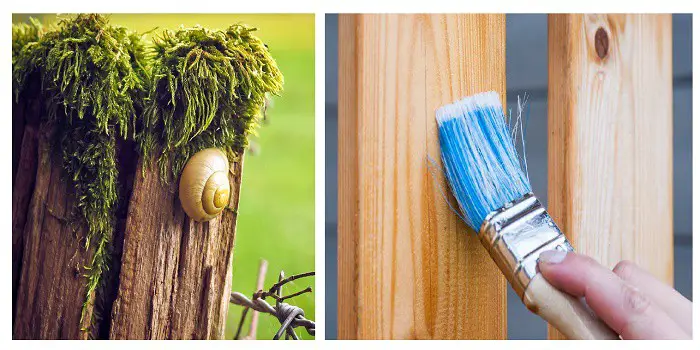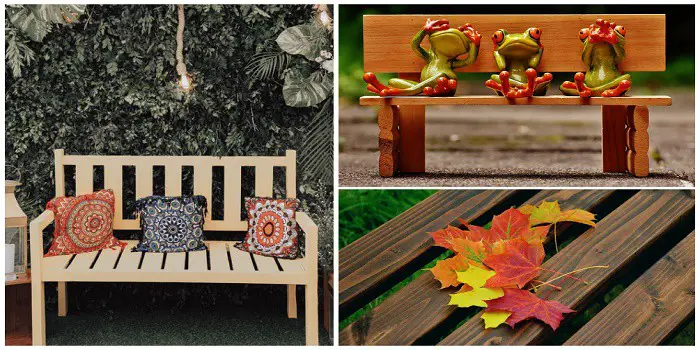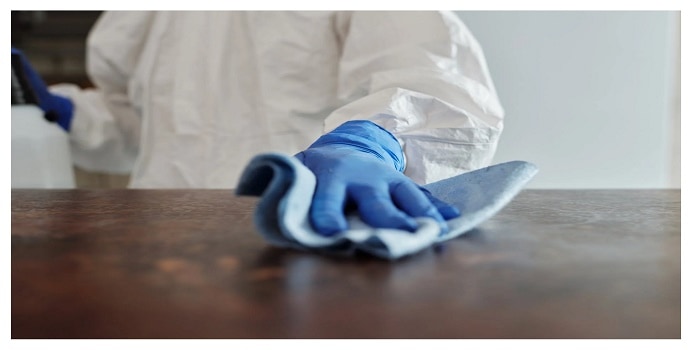
If you are going to protect the wood posts, decks, and fences from the elements, particularly water, then covering them with Bitumen paint is a good idea.
Bitumen paint creates a seal that protects wood from the damaging elements of water.
However, what if the wood you want to paint is still wet?
The bottom line is that you should never paint wood that is wet, no matter the paint you want to use.
This is because the paint will create a seal that will keep the moisture locked inside the wood. This is especially true with Bitumen paint.
The result will speed up the rotting process as the moisture has nowhere to go.
With the wood being unable to dry out, it will be like it is underwater and will start rotting away rather quickly.
Painting Wet Wood
In addition to being a bad idea to lock the moisture inside wet wood by painting it, the likelihood of the paint sticking is not very high.
Even Bitumen paint will have some difficulty sticking to the wood if the structure is still wet. This is because the wet wood will essentially repel the paint.
The result is that the paint will not stick properly from the start.
Or if it somehow does stick, the moisture inside will help push the paint away, which means it will not adhere properly.
This will generally come in the form of blistering, in which bubbles form under the paint, and the paint itself is being pushed away from the wood.
So, to achieve the desired results, you will want the wood to dry fully before you start painting.
What is Bitumen Paint?
Bituminous paint is a tar-like paint that is mostly used to waterproof roofing. However, it can be a practical coat of paint for walls as well.
For structures that are exposed to rainy conditions for most of the year, Bitumen paint is a good product to use.
It is specifically designed to waterproof wood, structural steelwork, and even non-plastic guttering.
You’ll find Bitumen paint used when re-felting a shed roof, as it will bond to the felting.
About the only downside is that the paint comes in black. So, if you are looking for other colors, that may be difficult, depending on their availability.

Applying Bitumen Paint on Wood
Because of the thick nature of Bitumen paint, it is best to use disposable paintbrushes when applying the product.
This is because once you have finished applying the paint, it will be difficult to clean the brushes after the job is over properly.
So, you are better off simply tossing the brushes away rather than trying to clean them.
You apply the first coat of Bitumen paint and allow 24 hours to let the paint dry. Then, apply a second coat for maximum effectiveness.
You can use Bitumen paint on several surfaces, including the following.
- Asphalt & felt roofs
- Roof decks made of concrete
- Asbestos-cement, slates, and tiles
- Metal sheeting made from steel, iron, lead, or zinc
In addition to the items mentioned above, Bitumen paint is often used on wooden posts as it preserves the material underneath. This is especially true for the portion of the post that is underground.
It is recommended that you apply Bitumen paint in temperatures that are above freezing but not too hot so the paint will have the best chance to stick.
Also, be aware that the most common brands of Bitumen paint will fully dry in about 24 hours.
There are some Bitumen paints that will allow you to touch the surface in 6 hours, but even then, it will take about 24 hours before it becomes fully dry.
That is why it is recommended that you want that period before you add a second coat.
Final Thoughts
If you are painting wood that will be exposed to the elements, especially timber that will undergo heavy exposure to rainwater, or snow, then Bitumen paint is the answer.
Although you can coat this paint over wet wood, it’s not recommended to do so because the paint will have a hard time adhering to it and will not help you get the results you want.
If you can, it’s always good to allow the wood to dry and then apply Bitumen paint.

Hi, I am Mark Garner a professional carpenter, woodworker, and DIY painter. I live in the small city of Peoria, Arizona as a semi-retired woodworker. I have started this blog with a simple motive to help you with my wood experience in this sector. If you like to know more about what I love doing and how it all got started, you can check more about me here.




